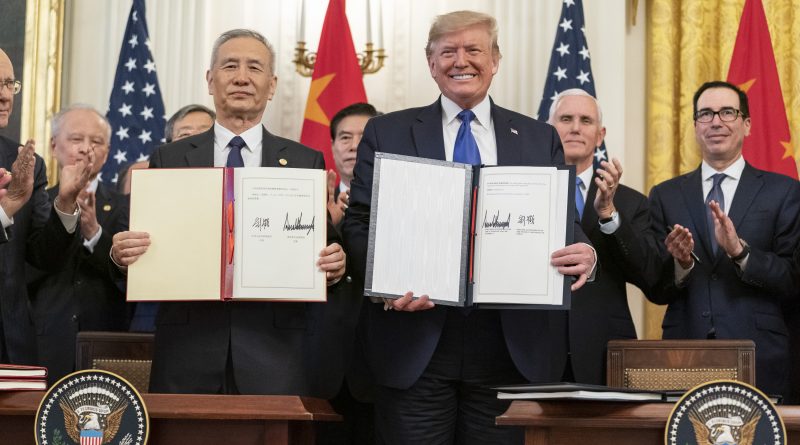The Beginning of the End to the Hegemonic Dispute Between China and the U.S.?
Julia Clapis
Staff Writer
Since July of 2018, there had been threats back and forth between the U.S. and the Chinese Governments. However, on January 22, 2020, in Washington D.C., President Trump and China’s Vice Premier Liu He took the first step towards a more definite, binding, and peaceful agreement. As stated by Bloomberg, “Phase one” of the trade deal has been completed.
In order to understand the essence of this conflict of interest, one must reason with the eventful past of the trade relationship between the two countries. The formidable trade war began due to uneven trade balance, which is directly related to a country’s trade deficit, as well as spending more money abroad than revenue brought in. In this case, it means that the U.S. imports more goods and services than it exports to China. The U.S.’s negative trade balance has been startlingly worsening since 1985. The deficit has increased from $100 billion in the early 2000s to that of $419 billion in 2018, according to the Office of the United States Trade Representative. One of the President’s electoral promises was to increase domestic consumption and stimulate the American industry. Essentially, the ultimate goal is to make Chinese products less compelling to American consumers. This can be achieved by increasing tariffs on Chinese goods and services, in turn making the products more expensive, and ultimately persuading Americans to buy more national products, making the demand for those imported products in the U.S. market decrease.
Due to China’s historical record of not complying with its trade deals, Americans worried whether Mr. Trump could carry this deal out. The goal was to bind China to respect the deal and make them abide by their obligations. To make sure both parties understand their commitment and responsibility to each other, the Bilateral Evaluation and Dispute Resolution was created, with the purpose, “to resolve issues in the economic and trade relationship of the Parties in a fair, expeditious, and respectful manner, and to avoid the escalation of economic and trade disputes and their impact on other areas of the Parties’ relationship” (Article 7.1 of the trade deal). Even so, Liu He has claimed that the imports in China will depend on its market demand. To some, this may be interpreted as Beijing viewing this deal as being rigid and abiding. There is no way, nonetheless, to predict if this indicates a possible lack of commitment of the Chinese Government with the trade deal.
To make sure China will comply with the continuity of the next two phases of the trade deal, the U.S. has established and intends to maintain 25 percent tariffs on about $200 billion on imported Chinese goods, according to CNBC, with the promise of China’s increase in the number of imports on American goods and services, focusing mainly on agricultural products and energy exports. This amount has been roughly divided in the following manner: $77.7 billion worth of manufactured goods, $37.9 billion on services, $52.4 billion on energy exports, and $32 billion on agricultural commodities. President Trump aims to benefit American farmers, who have suffered a great deal since the beginning of the trade war.
With such a significant investment in this trade relationship, other countries involved in trade with China, especially those in the European Union, are uncertain about the effects of this new American-Chinese trade deal on their economies and whether it will harm their own relations with China. However, according to Euractiv, negotiations between China and the EU are resuming
As stated by Forbes, the Chinese Government has also promised to take measures to improve its business ethics Mr. Trump criticized. Among the unethical behavior is the theft of intellectual property, with which U.S. businesses have long struggled with this issue in the Chinese market. Having this in mind, it was one of the main reasons for the commencement of negotiations with China. With the signing of phase one of the trade deal, China vowed to require transfers of valuable technology and trade secrets no longer.
Another issue within the US-China trade relationship was the Devaluation of the Yuan, the Chinese exchange currency, in relation to the U.S. Dollar. Logically, the more devalued China’s currency is, the more compelling become its goods and services, increasing demand for Chinese export to America. The devaluation of the Yuan also increases the deficiency of the American trade balance. However, this agreement determines that China’s foreign exchange reserves will be ultimately supervised, slimming the possibilities of China “manipulating its currency,” as President Trump has claimed.
Dr. Johnston, from the Stillman School of Business, was requested to comment on the matter:
“I’m excited to see China and the US making small improvements to end the trade war. As an economist, I am a believer in free trade. I have some concerns about how China and the US will enforce the new deal if either side violates the terms of the agreement as specifics about enforcement are light in the signed deal. Additionally, I have concerns about what will happen after 2021 as the deal is very short term in nature. Any uncertainty about trade in the future can make it difficult for businesses to make decisions and invest in the future thus potentially shrinking economic growth for both countries. Overall, the trade deal is positive progress in evading the trade war and I hope to see phase 2 of the trade deal signed in the near future.”
This trade deal is clear about its terms during the period between January 1, 2020, and December 31, 2021. However, it is unclear what will happen afterward. According to The New York Times, even though there is still an expected increase in American exports to China through 2025, there still remains a gap of insecurity and uncertainty. All there is to do is stand by and observe closely while the next steps are taken on the American-Chinese trade deal.


